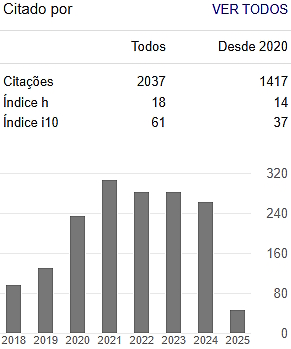EMERGENCY AND GROWTH OF Urochloa brizantha cv. Marandu IN THE FUNCTION OF SEED FOULING AND SOWING DEPTH
Abstract
The crop-livestock integration (ILP) consist in the adoption of several techniques, for better use of areas, formation and recovery of degraded pastures. The species of the genus Urochloa has been highlighted in the ILP and practices such as the type of seed used and the depth of sowing are fundamental for the establishment and production of the pasture. The objective of this research was to evaluate the emergence and growth of plants of Urochloa brizantha cv. Marandu, originating from seeds incrusted or not, sown in different depths and soils. The experimental design was a randomized block design with four replications. The treatments were arranged in a 2x5 factorial scheme, composed of two types of seeds (incrusted or not) seeded in five depths (0; 1; 2.5; 5; 10cm) in medium textured and clayey soils. Plants of U. brizantha from seeds incrusted and cultivated in medium textured soil presented higher emergence, but lower growth in relation to the plants coming from non-incrusted seeds. In soils of clayey texture, the use of incrusted seeds promoted a greater speed of emergency, but less growth of the plants. The sowing of U. brizantha at 1.0 and 2.5 cm depth provided a higher emergence speed, regardless of soil texture and type of seed. After forage cutting, the greatest tillering of regrowth was observed in plants from non-encrusted seeds and sown in soil up to 2.5 cm deep. At regrowth, there was no effect of treatments on forage yield.
Downloads
Downloads
Published
Issue
Section
License
Copyright (c) 2019 Colloquium Agrariae. ISSN: 1809-8215

This work is licensed under a Creative Commons Attribution-NonCommercial-NoDerivatives 4.0 International License.

